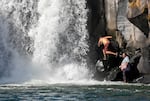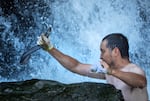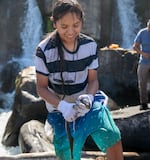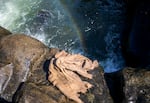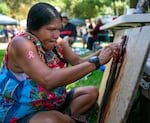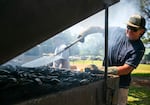At the base of Willamette Falls, a wall of 40-foot rocks towers over the reservoir. The falls are deafening. A mist hangs over the air.
Several people are submerged near the falls. They’re here every summer to catch lamprey the same way Indigenous people of the Pacific Northwest have caught them for millennia.
Ralph Lampman, a Lamprey Project Lead for Yakama Nation Fisheries, is one of them. He takes a deep breath and disappears under the water. The falls crash directly above him, hitting against sharp rocks to froth and spray the air.
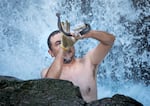
Ralph Lampman, who is Lamprey Project Lead for Yakama Nation Fisheries, holds up a lamprey harvested beneath a waterfall at Willamette Falls, near Oregon City, Ore., July 12, 2024.
Anna Lueck / OPB
Suddenly, he reemerges. “I got one!” he yells. Above his head, a long, scaleless, eel-like fish squirms in his fist, its round mouth waving in the air.
Lampman isn’t Indigenous, but a Yakama Nation tribal member taught him to catch lamprey eight years ago.
These harvesters are here to catch lamprey for an annual Willamette Falls lamprey celebration. Community members were able to gather in Clackamette Park to eat grilled lamprey and acknowledge the decreasing numbers of lamprey in the Willamette — a result of dams blocking their path upstream.
The tradition of catching lamprey by hand under the falls has fed generations of Indigenous communities over thousands of years. Lamprey join the likes of salmon and sturgeon as a first food, one of the foods that local tribes ate long before European contact.

Lamprey harvesters navigate slippery rocks, searching the pools and crevices where the eel-like fish often hide. Willamette Falls is a culturally significant place for many tribes in the Pacific Northwest, including the Yakama Nation, the Nez Perce Tribe, the Confederated Tribes of the Umatilla, the Confederated Tribes of Warm Springs and the Confederated Tribes of the Grand Ronde.
Anna Lueck / OPB
But the environment where lamprey long returned to reproduce is changing. Their numbers are falling dramatically. If conservation efforts are not implemented, there won’t be any lamprey left for future generations.
A threat to their survival
The lamprey is one of two species of jawless fish that have roamed oceans and rivers for 340 million years. That’s why Erik Holt, a member of the Nez Perce tribe and chairman of their fish and wildlife commission, calls them “the grandparents of the river.”
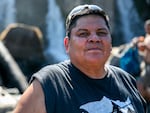
Erik Holt, a Nez Perce tribal member and Chairman of the Nez Perce Tribal Fish and Wildlife Commission.
Anna Lueck / OPB
“They’ve lasted through ice ages, through everything you can imagine, for millions of years,” he said. “They’re the ones that are the most important. We can’t lose sight of that.”
Lamprey are long, scaleless and slimy. They have round, toothed, perpetually open mouths with suckers that help them attach to rocks and fish.
After hatching, the lamprey develop their four eyes and sharp teeth in freshwater before migrating to the ocean. Then they spend one to three years feeding on fish as parasites.
Much like salmon and sturgeon, lamprey have to migrate back to freshwater to spawn. Before dams, they were able to suck on rocks and squirm their way upstream. But now, dams are creating an enormous obstacle.
Before the 1970s, annual lamprey numbers collected at Bonneville Dam were more than 250,000 fish, according to a report from the Pacific Lamprey Conservation Initiative, which is a collaborative project between different levels of government, Indigenous tribes and non-governmental organizations to preserve the species. But 30 years later, that number had dropped to 52,000.

FILE-The fish ladders at the Bonneville Lock and Dam, in 2021.
Kristyna Wentz-Graff / OPB
When populations of salmon and sturgeon dropped, fish ladders were built at Bonneville Dam in 1937. Fish ladders are like stairs for salmon, meant to mimic the natural currents, temperatures and height of the streams salmon are used to swimming through.
But lamprey don’t swim upstream in the same way that salmon do. They have to suck onto the ladders and push themselves up. Fast currents and corners of the steps mean lamprey can’t get a good grip, and often get washed back down the ladder.
Only half the lamprey that attempt to cross Bonneville make it to the other side. It can take them days. Sometimes if they can’t climb the ladders once, they don’t try again.
Related: Tribes celebrate as lamprey make a comeback on Willamette
Ladders that target both salmon and lamprey swimming patterns have been implemented in eight dams, including Bonneville, but lamprey populations are still nowhere near what they were decades ago.
Tribes are stepping in to help.
Sara Thompson is a member of and spokesperson for the Grand Ronde Tribe. She said the tribe has been partnering with different organizations to study the most effective ways to increase lamprey populations.
“We partnered with Oregon State University and Oregon Department of Fish and Wildlife from 2006 to 2013 to do a study on migration,” she said. “We wanted to understand the range and timing of lamprey throughout the Willamette Basin.”

Tribal lamprey harvesters from several Columbia Plateau tribes approach Willamette Falls, near Oregon City, Ore., July 12, 2024.
Anna Lueck / OPB
The Grand Ronde Tribe also did a study of a method called translocation, where tribes collect the lamprey in trucks, transport them past Bonneville Dam and release them into freshwater.
“We wanted to see if that translocation would create pheromones to attract other adult lamprey to facilities at the dam and determine if those translocated lamprey could survive the winter and spawn the following spring,” she said.
The Nez Perce Tribe, Confederated Tribes of the Umatilla Indian Reservation, and Yakama Nation also use translocation to help lamprey bypass dams completely.
Each tribe brings about 3,000 lamprey upstream per year through translocation. It’s helpful, but Holt said it isn’t sustainable. The Nez Perce tribe is based in Idaho, making it a seven-hour drive to Bonneville Dam.
Related: Oregon seeks $27.6 million for Winchester Dam work linked to mass death of Pacific lamprey
More accessible ways to help lamprey complete their migration, like lamprey-specific ladders and increased research and tracking, require more state and federal funding, Holt said.
And, Thompson said, lamprey need more awareness.
More than just a fish
Conservation projects focused on salmon and sturgeon generally receive more attention and funding than lamprey.
There are many reasons why.
For one, Holt said the animal’s looks could play a part.
“The look of an eel sometimes scares people,” he said. “It’s not a pretty fish. People look at salmon and steelhead in a different way. But for us Indian people, they’re the same. They’re all sacred to us.”
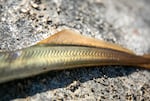
The dorsal fin and striped body of a Pacific lamprey, harvested at Willamette Falls. Lamprey are an ancient family of fish, between 350 and 400 million years old, that also historically served as an important food source for Columbia Basin tribal communities.
Anna Lueck / OPB
Thompson said the superficial ideas about lamprey carry into government reactions too.
“The Oregon Department of Fish and Wildlife once viewed them as a trash fish,” she said. “There were efforts to remove them out of rivers and streams because they were clogging up irrigation pipes.”
She said lamprey are often treated differently than salmon — which she called “the icon of the Pacific Northwest” — simply because lamprey have been viewed as a problem.
And there are misconceptions about lamprey, related to their presence in the Great Lakes. In the 19th century, sea lamprey entered the Great Lakes system from the Atlantic Ocean through shipping canals.
Because they aren’t indigenous to the lakes, they don’t have natural predators. Their presence disturbed the natural food chain, causing the collapse of lake trout, whitefish and chub populations, and the near-destruction of the ecosystem.
Related: Lamprey kill prompts search for accountability at Winchester Dam
The negative connotations related to invasive sea lamprey from the Atlantic can affect general perspectives on Pacific lamprey, despite their beneficial effects in the Northwest.
Apart from being a Lamprey Project Lead, Lampman is also a lamprey biologist. He worked for the U.S. Forest Service when he first learned about the species. The oddness of the creatures drew him in. At the start of his research, he said he took videos of lamprey to send to experts to learn more.
“But even the experts didn’t seem to know that much about lamprey,” he said. “I felt like somebody really needs to understand them better.”
So, he learned to catch and trap lamprey from different tribal members and began tagging and tracking the fish. Increased research on lamprey populations help people better understand the way environmental changes are affecting them. And it helps emphasize the significance of lamprey for tribes.
Courtney Whitefoot is the Yakama Nation Cultural Center’s marketing coordinator. She said an important part of her work is educating non-Indigenous people on how lamprey are more than just fish.
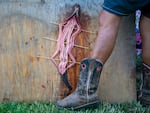
Eunice Mathias, a member of the Wanapum tribe of the Yakama Nation, cleans and prepares a lamprey for drying at the Willamette Falls Lamprey Celebration. Mathias said lamprey preservation was traditionally women's responsibility within the tribe and that she learned the process from older relatives when she was young. "We had no excuses," she said. "We had a lot of people to feed."
Anna Lueck / OPB
“A lot of outside people don’t know that the eels are significant to our tribe and the cultural importance of them,” she said. “I think (outreach) gives people a reason to come and learn a little bit more about our history and culture.”
The significance of lamprey for tribes can be as simple as “it’s always been on the table,” Whitefoot said. From a young age, many Indigenous people of the Pacific Northwest have enjoyed fileted and grilled lamprey in ceremonial dinners.
Thompson said a big part of the lamprey’s role in the lives of local Indigenous people is its reliability.
“It has always been one to help provide food for our communities, for our ancestors,” she said. “and while they may not be the prettiest fish and they may not be salmon, the icon of the Pacific Northwest, their importance and their impact shouldn’t be diminished.”
But a decrease in lamprey population means younger generations have less access to the fish that has sustained their ancestors, and to the traditions that surround them. And that means those younger generations won’t understand the importance of protecting the lamprey from extinction.
“In tribal culture, a core value for us is providing for the community, providing for our elders,” Thompson said. “I think that’s something that you see handed down through the generations and something that is very much alive and well within tribal communities.”
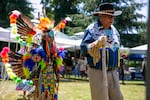
Davis Yellowash Washines, right, a citizen of the Yakama Nation and Willamette Falls Trust Chairman of the Board, joins the opening procession of dancers at the Willamette Falls Lamprey Celebration in Oregon City, Ore., July 12, 2024. Washines says, "We're glad that a lot of young people are here, a lot of children are here, because they are the ones that are going to carry on long after we are gone."
Anna Lueck / OPB
The idea of providing can be a motivator for younger generations to carry on catching lamprey.
So can stories.
Holt remembers the legend story of the lamprey that his grandparents told him as a kid.
“The (lamprey) was playing a card game. He kept betting against the coyote, and he kept losing,” the story went. “Finally he got down to where he had to bet his bones. So the eel bet his bones and lost to the coyote.”
Tales like these have been passed down from generation to generation, teaching children about where lamprey come from and how they came to be. Without stories like these for younger generations, a fish that has lasted for hundreds of millions of years will be lost forever.
“Whether they’re young or old, (we) try to pass on the word about these lamprey and explain some of the stories behind them,” Holt said, “reminding them that the eels are the grandparents of the river.”

